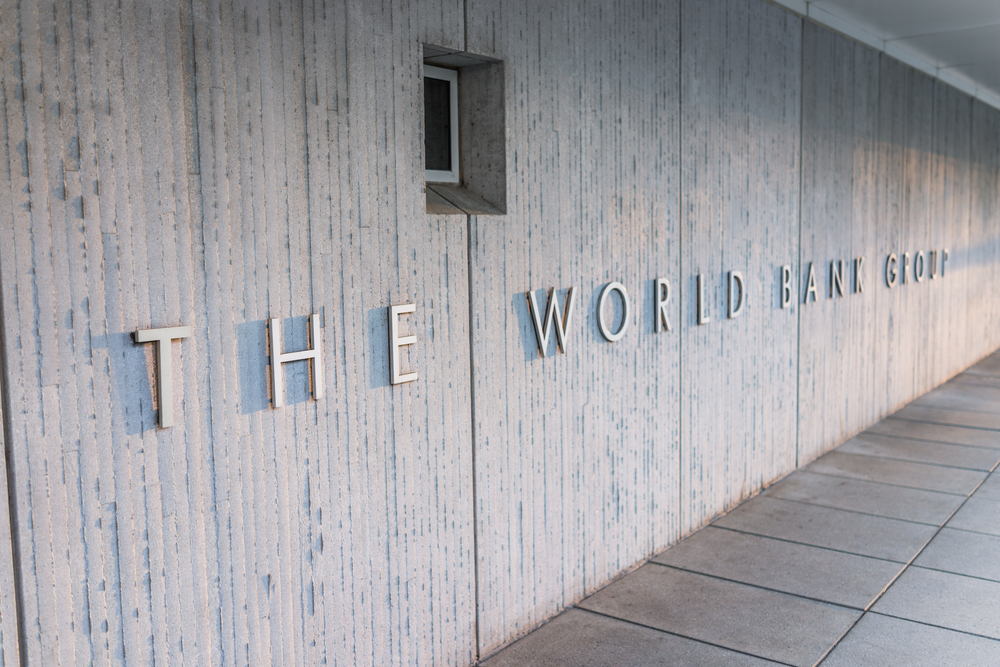
The World Bank sign in Washington DC. Image rights: Kristi Blokhin via Shutterstock
The World Bank revised its growth forecasts for 2023 to 2.1%, from 1.7% in January, due to better-than-expected performances from major currencies. This was revealed in the Washington-based body’s half-yearly update yesterday.
Looking ahead, the World Bank sliced a little off its forecast for 2024, which was revised to 2.4% from 2.7%.
Despite this, chief economist at The World Bank, Indermit Gill said, “The world economy is in a precarious position.” He continued to warn global growth could be lower should banking stress worsen or inflation continue to prompt higher-than-expected interest rates.
The US greenback strengthened yesterday after unexpectedly soft services data. The dollar gained 0.22% on the euro and just over 0.11% against the pound but failed to maintain these gains into this morning.
In the news, more UK banks have pulled hundreds more home loan deals as fixed rates continue to rise. It’s reported that the mortgage market turmoil has prompted record numbers of people to take out loans that exceed 35 years.
It was a quiet day for data across our major currency zones yesterday, however in Canada, the Ivey Purchasing Managers Index (PMI) dropped to 53.5 in May 2023. This was below market forecasts of 57.2 and the reading indicated that Canadian economic activity slowed for a second consecutive month.
The industrial output in Spain decreased 0.9% year-on-year in April after a downwardly revised 4.1% increase in March, despite forecasts of a 1.5% rise. This reflects the first decline in the industrial sector in five months.
US stocks The Dow Jones remained around the flatline yesterday, while the S&P 500 rebounded to near nine-month highs and the Nasdaq gained 0.3%. Investors across the continent remain cautious and consider the mixed impact of economic data on the books for the Federal Reserve nest week.
This morning economists in Asia digested China’s Balance of Trade which dropped to $65.81bn from $78.40bn in the same period a year earlier. It was the smallest trade surplus since February and was impacted by a decline in exports, which fell more than imports.
Later today, economists will receive US Balance of Trade data, which is expected to contract to -$78.2bn from -$64.2bn in March.
Make sure any upcoming transactions are protected against the risks of sudden market movements. Secure a fixed exchange rate now with a forward contract; call your Business Trader on 020 7898 0500 to get started.
GBP: Modest growth for the construction sector
Despite a lack of key economic data yesterday, the S&P Global/CIPS Construction PMI came in at 51.6, from 51.1 and slightly over market expectations of 51.5. This modest growth was driven by faster rises in commercial and civil engineering activity and represents the strongest upturn of activity since February.
GBP/USD: the past year
EUR: Retail sales flatline
Yesterday economists heard that retail sales in the Euro Area remained unchanged in April, following just under half a per cent decline the month before. This fell short of market expectations which forecast a 0.2% growth. Looking at the same data at this time last year, retail sales are 2.6% lower.
USD: Economists ponder Fed’s plans
The US dollar had a wobbly session on Tuesday as expectations of a rate hike diminished from the Federal Reserve (Fed). Next Wednesday, the Fed will announce the latest interest rate decision which is currently forecast to remain unchanged at 5.25%.
For more on currencies and currency risk management strategies, please get in touch with your Smart Currency Business trader on 020 7898 0500 or your Private Client trader on 020 7898 0541.

 020 7898 0500
020 7898 0500